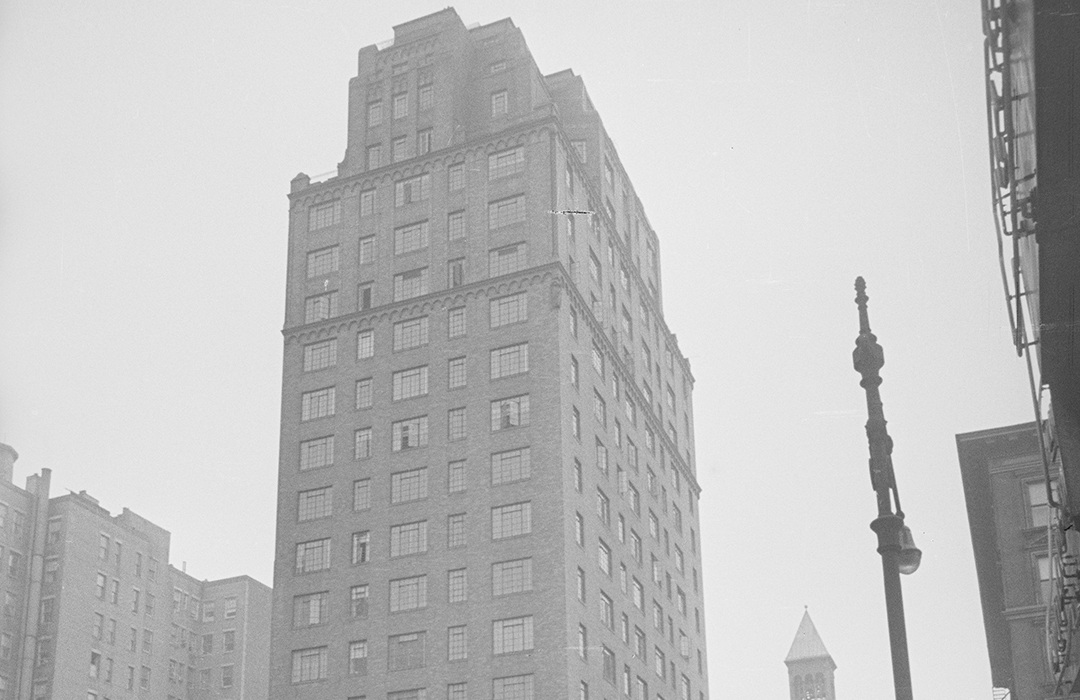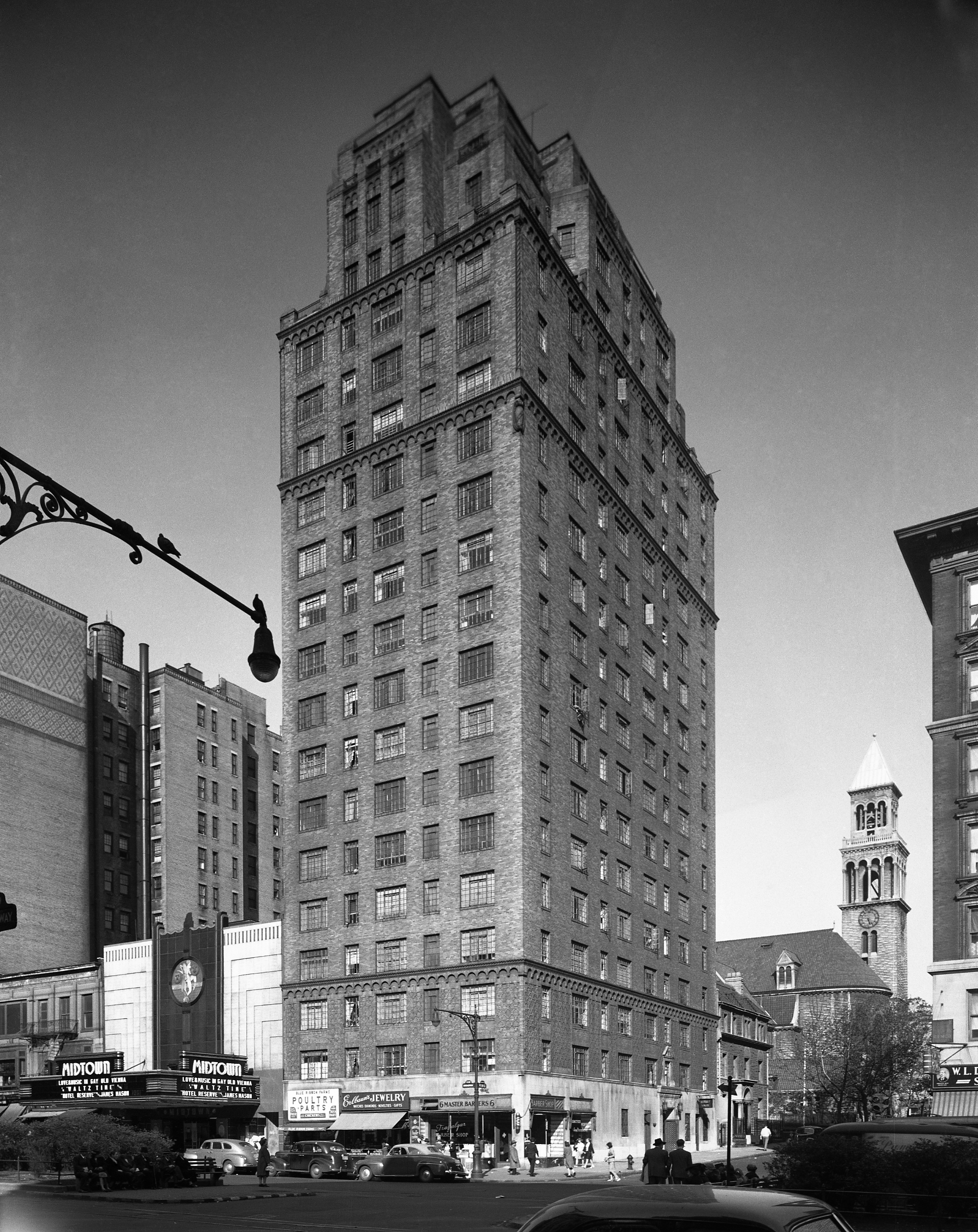
The Trafalgar Towers
by Tom Miller
In 1930, the first full year of the Great Depression, Irving Broff purchased the five-story brick apartment building that had stood on the northeast corner of Broadway and 99th Street since the late 1880’s. Broff, who owned the Trafalgar Construction Company, was just getting started in real estate development on the Upper West Side. He demolished the vintage structure and hired architect George G. Miller to design a modern replacement building, to be called the Trafalgar Towers.
The 19-story and penthouse edifice rose with blinding speed. Miller filed plans in February and construction was completed by September 1—at a cost of $500,000, or around $7.75 million in today’s money. Clad in variegated beige brick, Miller’s Italian Renaissance design featured terra cotta corbel tables that divided the building’s mass into four sections.
There was a total of 88 apartments in the building, and its residents enjoyed a Depression Era perk. On September 13, 1930, The New York Sun wrote, “Trafalgar Towers, as the new building at 233 West Ninety-ninth street…is named, is one of the few new buildings on the West Side which is offering its tenants free gas for cooking and refrigerating purposes.” The article noted, “Its apartments of one and a half, two, three and four rooms have been so arranged that every one of them, with the exception of a few one and a half room units, are to have real sunshine.” Other amenities were “metal clothes hampers,” built into the bathroom walls, and wooden Venetian blinds on the casement windows. The article said, “Special detached dinettes to with some of the three-room apartments, and the usual dining alcove are part of the four-room arrangements.” Rents averaged an affordable $650 per month by today’s standards.
Other amenities were “metal clothes hampers,” built into the bathroom walls, and wooden Venetian blinds on the casement windows.
Among the early tenants were Alfred Frank and his wife, who maintained a summer home in Sayville, Long Island. The couple had not been in their Trafalgar Towers apartment long before Frank’s wife died. Grief-stricken, he turned to spiritualism to reconnect with his wife. And, at least to him, it seemed to work.
According to The Suffolk County News on December 22, 1933, a few days her death, Frank told Elsie Kroncke, who lived across the street from the Franks in Sayville, “that his wife had returned to his home at 233 West 99th street, Manhattan.” Mrs. Knocke testified, “Mr. Frank told me that he was sitting on a couch in his home, and suddenly he saw his wife materialized and danced into the room. He said she went over to him, held his hand, patted his cheek and spoke to him.”
Among the things his wife spoke to him about was his will. She told him to change it, leaving his entire estate to Fritz Muller, her third cousin who lived in Germany. After the encounter, Frank became increasingly frantic to reconnect with his wife. He became close with another Trafalgar Towers resident, Frank Decker, a “spiritualistic medium,” according to the Daily News. Decker’s wife, Salma, was also a medium. The newspaper described her as “one of the highest paid physics and astrologists in the United States.”
Decker instructed Frank to buy copper plating to place around his abdomen, wrists and head, explaining that it would help him communicate “with ‘Patsy, the King of the Spirit World.’” Mrs. Krnocke told of the time she found Frank wearing the copper items and “standing in a copper bowl filled with water, and he told me he was going to hook up the cooper bands with the electric light, so he could get a clearer connection as his wife’s voice had not been very clear.” She told him, “That’s a fine way to kill yourself.”
Alfred Frank died on August 9, 1933, and his will reflected his ghostly wife’s instructions. Frank’s brother, sister, and nephews went to court, saying he had “become mentally deranged as a result of his intense interest in spiritualism.”
Frank Decker was having problems of his own at the time. On September 10, 1933, the Daily News reported, “Frank Decker…may have to call on friendly spirits to keep him out of alimony jail because of $648 arrears due to his seeress wife, Mrs. Salma Decker.” Salma moved out and filed a suit for divorce on August 26, 1931, “naming Cloretta Lavilla, a movie actress,” as the other woman, according to the article. Salma Decker told a reporter, “My husband told me he wished to spread his wings. He said he did not wish to be tied down with a family or let marriage interfere with his spiritualistic career.” She alleged Decker maintained a separate apartment for him and Cloretta Lavilla in the Parc Vendome Hotel.
Decker responded that his wife made much more money than he, and he was not a drunk as she suggested. “My illness is not due to dissipation, as my wife charges, but to fear and anxiety caused by her threats to put me in Alimony jail and the character of my work, which requires me to sit in a trance for hours in hot, stuffy and dark rooms.” He asked the court to set aside the $25-a-week alimony. The judge reserved his decision on the matter.
On August 6, 1938, the New York Post reported, “Burton L. Johnson, seventy-five, a race horse handicapper, fell to his death from his bedroom on the eighth floor of 233 West Ninety-ninth Street at 7:40 last night.”
New Yorkers suffered through a stifling heatwave in August 1938. Decades before air-conditioning would become commonplace, city dwellers slept on fire escapes, roofs, and even on the riverbanks to try to keep cool. It may have been that quest for a bit of cool night air that proved fatal to one Trafalgar Towers resident. On August 6, 1938, the New York Post reported, “Burton L. Johnson, seventy-five, a race horse handicapper, fell to his death from his bedroom on the eighth floor of 233 West Ninety-ninth Street at 7:40 last night.”
In July 1970 maintenance workers went on strike. Without elevator operators, porters, and other employees, residents took up as much slack as they could. But, nevertheless, apartments went without hot water, and, because the Sanitation union honored the strike, garbage piled up in apartment buildings. Ten days into the strike things were becoming dangerous at the Trafalgar Towers. It was one of ten Upper West Side buildings deemed by the Health Department on July 15 as “having emergency situations.”
The Trafalgar (the “Towers” was dropped at some point) was converted to co-ops in 1985. Although the ground floor has been abused, other than replacement windows the Trafalgar is little changed since it opened in September 1930.
Tom Miller is a social historian and blogger at daytoninmanhattan.blogspot.com
Building database
Keep Exploring
Be a part of history!
Think Local First to support the businesses at 233 West 99th Street:
Meet Mohinder (Paul) Gulati!
Meet Steve and Denise Boockvor!
Meet Malaga Baldi!
Meet Josh Wong!



